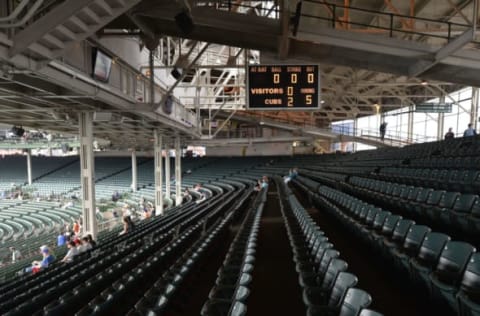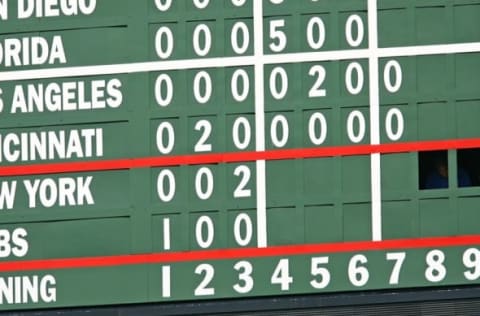Chicago Cubs: 1984 – A retrospective of a classic year


After what seemed like decades of misfortune and woe, everything changed for the Chicago Cubs in 1984, when they found success in an unlikely place.
The history of the Chicago Cubs certainly has some bright spots, many of them coming in the past few years. The team’s history is long and arduous, forcing us to break down parts of years or even decades to understand what went right or wrong.
For the Chicago Cubs, the 1984 season was a sort of reprieve from the previous 12 seasons of below-average baseball. The team was coming off a string of seasons finishing right at or below .500. The season before, they finished a balmy 73-89. So what exactly was the catalyst for all of a sudden posting a 91-win season and an eventual NLCS bid?
The club seemed destined to turn their luck around when then-GM Dallas Green, began making a flurry of moves in the offseason. Trades swirled around, bringing fresh faces to the Windy City. Everything was suddenly clicking on all cylinders and the Cubs, for one spectacular year, were back.

Chicago Cubs: Whirlwind of transactions
The offseason began when the team shipped off a player-to-be-named and a 23-year-old minor league pitcher named Stan Kyles to the Oakland Athletics for a reliever by the name of Tim Stoddard. For the Cubs, Stoddard provided 92 innings, pitching to a 3.82 ERA. That year, he posted a career-high strikeout rate and a decreased HR/9. Stoddard also appeared in the second-most amount of games, behind only closer Lee Smith.
Green began wheeling and dealing guys left and right in an attempt to bring as much value to the club as possible. The number of transactions Green was making brings into thought the modern day GM, and most importantly Seattle Mariners GM Jerry DiPoto, who is infamous for continually making trades. It became a reality for the Cubs in a bid to contend.
Midway through the first part of the season, the Cubs made a couple of season-defining trades. To bolster their starting rotation, they shipped off the infamous Bill Buckner to the Boston Red Sox in exchange for Mike Brumley and Dennis Eckersley. The Cubs also sent Bill Campbell, Mike Diaz to the Philadelphia Phillies in a deal where they acquired Gary Matthews.
More from Cubbies Crib
- Cubs starting pitching has been thriving on the North Side
- Make no mistake: the Cubs are very much about power hitters
- Cubs are giving pitcher Javier Assad a deserved shot
- Cubs: It’s time to start thinking about potential September call-ups
- Cubs: P.J. Higgins deserves to be in the lineup on a daily basis
Brumley never amounted to anything for the Cubs. However, Eckersley would help to anchor an uup-and-down starting rotation. That year for the Cubs, he started 24 games, finished 10-8 with a very respectable 3.03 ERA. He threw two complete games in that span, pitching to a 3.40 FIP and a 3.2 fWAR.
Throughout the season, the Cubs continued to wheel and deal. In a move that would have repercussions for a long time, they traded then 23-year-old rookie Joe Carter in a seven-player swap.
Among the return, Rick Sutcliffe became the most excellent piece of the bunch. Carter went on to win the American League MVP a couple of short years later. For Sutcliffe that year, he drove the rotation with his Cy Young-winning season, finishing 16-1 with a 2.69 ERA, and seven complete games.
Matthews, meanwhile, was a wrecking ball for the Cubs in 1984. He played in 147 games, slashing .291/.410/.428 with 14 HR and 82 RBI. The slugging outfielder produced a .381 wOBA, 135 wRC+, and a 2.8 fWAR. That year, he finished fifth in the National League MVP voting.

Chicago Cubs: Production from the unlikeliest of sources
The 1984 Cubs starting lineup boasted the likes of Ryne Sandberg, Gary Matthews, Ron Cey and Leon Durham. A fairly formidable group. That being said, much of the success for the Cubs that season was found in unlikely places.
The first was outfielder Thad Bosley. In a platoon role, Bosley saw action in 55 games that year, totaling 112 plate-appearances. In that span, Bosley slashed .296/.375/.418 with two home runs and 14 RBI. He also posted an above-average wOBA of .353 and wRC+ of 116. He became a consistent player for the Cubs for a couple of seasons before being shipped out and fading out of baseball a couple of years later.
More from Cubbies Crib
- Cubs starting pitching has been thriving on the North Side
- Make no mistake: the Cubs are very much about power hitters
- Cubs are giving pitcher Javier Assad a deserved shot
- Cubs: It’s time to start thinking about potential September call-ups
- Cubs: P.J. Higgins deserves to be in the lineup on a daily basis
Richie Hebner was a second prominent producer for the club who nobody batted an eye. Hebner was a 36-year-old journeyman third baseman who spent the bulk of his career with the Pirates. After leaving Pittsburgh, Hebner jumped between the Phillies, New York Mets and Detroit Tigers before landing with the Cubs for his final two seasons.
That year, he played in just 44 games, however, saw 91 plate-appearances and slashing .333/.407/.444 with 2 HR and 8 RBI. Hebner also managed to produce a way-above-average .380 wOBA and 135 wRC+. It would be the final year of his career, as Hebner went out in style while helping the team in a big way to the postseason.
The final guy of the underrated group is Jay Johnstone. Similar in a sense to Hebner, Johnstone was a whopping 38 years old, his second-to-last season in the big leagues. Because Johnstone was a platoon guy as well, he saw just 52 games. The veteran did, however, record 82 at-bats, making the most of them.
While not hitting a single home run across the span and driving in only three runs, Johnstone still slashed .288/.350/.370 with a .308 wOBA. As a 38-year-old, not too shabby. While the production is also not as great as Bosley or Hebner, Johnstone still found a way to keep his average up enough to help out the club.

Chicago Cubs: Turning it all around
The year before, in 1983, the Cubs finished a paltry 73-89. It was one of many lackluster seasons where the team could not win. By the finish of the 1984 regular season, the club had recorded a 96-win season and a trip to the League Championship Series against the San Diego Padres.
At the time, the Division Series did not exist for the two leagues, so the postseason consisted of only two rounds. The series was also still a best-of-five. The Division Series would not exist until 1995.
In Game 1 of the series, the Cubs dominated in all facets of the game. They battered Padres starter Eric Show for five runs before dumping seven more on Greg Harris, winning the game 13-0. Sutcliffe pitched seven shutout innings with eight strikeouts and five walks.
In Game 2, the Cubs found themselves one win from a World Series appearance, taking it 4-2. Steve Trout pitched phenomenally, throwing 8 1/3 innings while allowing just two earned en route to the victory. It would, however, be the final bright moments on the Cubs’ season.
Dennis Eckersley got the ball with a chance to clinch the series in Game 3. After the Cubs struck early on an RBI hit from Ron Cey, the middle innings ran foul for Eckersley quickly, as he finished with 5 1/3 innings pitched and five earned runs. The fall began.
The Cubs lost the series after a furious three-straight wins from the Padres, who lost handily to the Detroit Tigers in the World Series. Steve Garvey found himself named NLCS MVP, after an impressive three-game performance.
Next. Chicago Cubs: How good was that 2003 squad?. dark
The 1984 season would stand out amongst the general fray of the average performance from the team throughout most of the 1970s and 80s. Following the heroic run to the Championship Series, the team faded back into mediocrity the immediate next season, finishing 77-84.
In fact, throughout the next handful of years, they averaged only 75 wins per season. It would not be until the 1989 season where the team would even sniff the playoffs. Nevertheless, for a moment and a season, Cubs fans could relish in a fantastic year, enjoying the excitement the team had brought together.